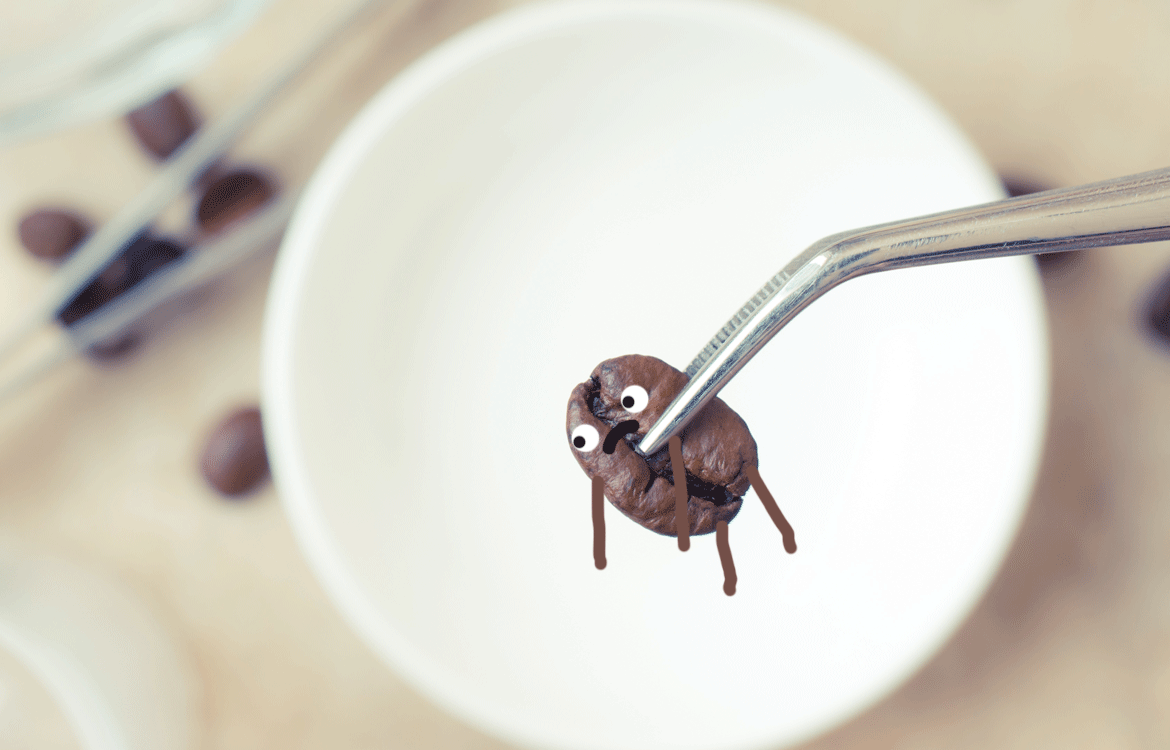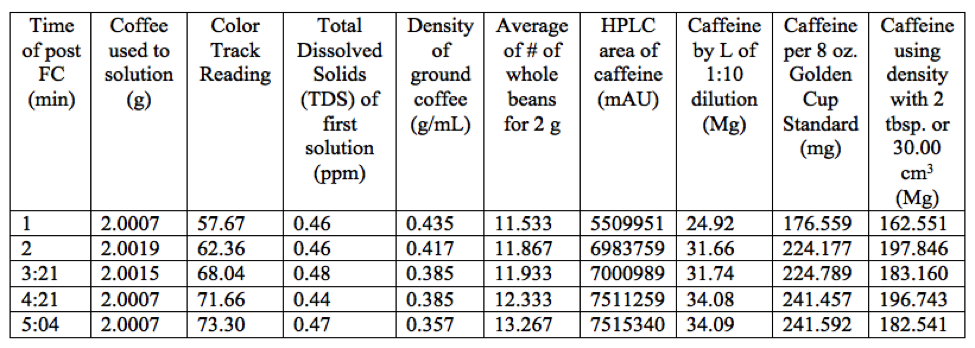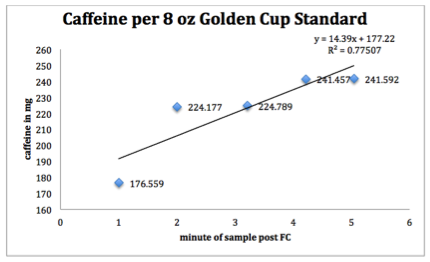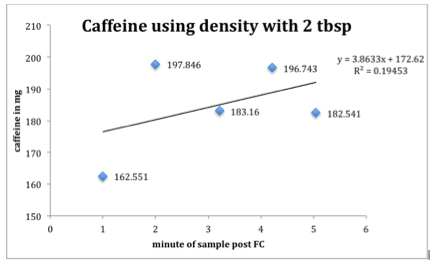
When it comes to coffee, there’s something everyone’s talking about and nobody is talking about: caffeine. For people who drink and enjoy coffee, caffeine is on the mind and a wonderful tasting cup is a big bonus. For the folx who work in the coffee industry, we tend to want to think we’re in the deliciousness business and a part of a beautiful value chain, not that we’re administering legal drugs in liquid form. Of course, great coffee can be both things, but as is so often true about the common and ubiquitous, very little is known about the science of caffeine consumption, and there are many misconceptions around it.
Juliet Han has been pulling double-duty as the head roaster at Blue Bottle while also continuing her studies at Peralta Colleges in Oakland with a focus on science, and naturally she researches coffee whenever she can. In her just-published research paper Correlation Between Caffeine and Roast Levels Using HPLC she took on the question, “Does dark roast have more caffeine than light roast?” This is one of the most common misconceptions around coffee, and while it is something that’s been studied in the past, Han’s 15 years of varied industry experience give her a practical lens to see the question through.
Han started by considering the question and pulling it apart: Does dark roast have more caffeine than light roast? As with most questions about coffee, it depends. Even if you assume the brewing is performed consistently, when you say “more caffeine,” you’re talking about more… in what? In the cup? In the beans? In the grounds? How are you measuring the coffee? Each answer yields a different approach to the question, different scientific variables, and ultimately, different conclusions.
In her research lab, among the various tools and instruments, Han had access to an HPLC (high pressure liquid chromatography) machine, which is a common scientific tool that takes a sample and analyses it for what components are in there and in what quantities. The details of her methodology and data are in the research paper, but let’s summarize what she learned and why it matters, categorized by how we might frame the caffeine/roast question.

By the bean
One way to think about this question is: Do caffeine levels change inside the beans during roasting? On this, the science is clear: caffeine is very stable through the roasting process. You’d have to roast it past turning it into charcoal before caffeine would chemically change, beyond even the darkest of dark roasts you could find. Point is, even though the individual beans go through physical and chemical changes while it’s roasted, the amount of caffeine a bean starts with is generally the amount it ends up with. If you’re talking about individual beans, the caffeine level is the same whether it is light or dark roasted.
Of course, while this may be interesting as a bit of trivia, it’s not that relevant to our day to day coffee lives, unless you’re a coffeebeanophage, which means “person who eats whole bean coffee” and is also a word I just made up.
By the cup and weighing the grounds
Han wanted to take the variables of brewing out of the picture, so she brewed the coffee by “decoction,” which means brewing coffee by actually boiling the coffee in water. She brewed the living hell outta the coffee, extracting pretty much all the coffee that’s soluble. Boiling it for 15 minutes (as she did) is a lot, and the coffee surely tasted gross and bitter.
Coffee nerds like to weigh the coffee grounds we brew. Mass is a constant, and scoops or tablespoons give you a variable that’s imprecise and inaccurate. (Sorry, scoop lovers.) Different coffees can have very different physical characteristics, so it’s a bit misguided to think that there’s a magic brewing recipe that works all the time.
What Juliet found was that when she weighed the coffee grounds and based her calculations on that, the darker roast did in fact yield more caffeine than the lighter roast.
By the cup and by the scoop
But what if you just can’t put down that spoon or scoop? Not everyone has or wants a scale, and however imprecise scoops and spoons may be, it’s still the most common way most home coffee brewers measure their grounds. Measuring this way introduces the density of the coffee grounds into the calculations, and Han also did the calculations to see what the results were if someone used tablespoons or scoops.
Turns out that even when using volume to measure the coffee, the darker roasts still resulted in more caffeine than lighter roast.


What does this mean?
I’ve gotta tell you, I love Han’s research paper. There’s a lot to love about it, but what I love most is that it inspires so many more questions and possibilities for future research.
According to this research, dark roast does in fact yield more caffeine than light roast. This is consistently what Han found across experiments, and it makes sense, though not for the reasons one might think. A darker roasted coffee is less dense, so by the bean, it has lower mass than a light roasted coffee. All other things being equal, if you grind and weigh out a certain number of grams of coffee, there are more beans involved when using dark roast. It’s no different than if we ate a pound of fresh grapes versus a pound of dried raisins—far more sugar is consumed in the dried, condensed raisin equation.
So it’s not necessarily that “dark roast has more caffeine”—caffeine is stable across roasts—but rather, dark roast is less dense. Since the caffeine is so stable, the difference mostly boils down to density.
What I think it’s interesting to note is that when you look at Han’s data, the caffeine difference between the lightest and darkest coffees was around 9% when you measured by the scoop, but about 32% when she measured by weight. That’s a big margin! While it’s the density difference between the dark and light roast coffee that gives us the difference in caffeine content, the fact that a scoop of dark roast has less mass than a scoop of light roast actually reduces the net caffeine difference in the scoops-and-spoons scenario. So while darker roast does have more caffeine, that difference is more pronounced when you measure by weight than if you’re scooper.
32% is a fairly meaningful difference. It means that 16 ounces of Han’s light roast brew would have about as much caffeine as 12 ounces of the dark roast. But when you’re thinking about how this applies to your coffee consumption, keep in mind that Juliet Han is a scientist professionally controlling her variables. Once you leave the lab and get out into the world of coffeeshops and home coffeemakers (not to mention different coffees and roasters and brewing waters and brewing variables), you’re faced with the unfathomable number of factors that affect caffeine content beyond just roast level.
All in all, it appears that dark roasted coffee has more caffeine, but not for the reasons you think. That is a great bit of trivia to pull out the next time somebody brings this up at a party. “You know, dark roasted coffee has more caffeine, but not for the reasons you think!”
I can’t wait to see what other research Han and other coffee-knowledgable scientists come up with next. Go science!
Read the full academic paper from Juliet Han via Medium.
Nicholas Cho (@nickcho) is a coffee professional based in San Francisco. This is Nicholas Cho’s first feature for Sprudge Media Network.
Top image © Photosiber/Adobe Stock
The post Does Dark Roast Coffee Really Have More Caffeine? appeared first on Sprudge.

